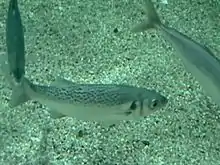Spotted seabass
The spotted seabass (Dicentrarchus punctatus) is a species of ray-finned fish belonging to the family Moronidae, the temperate basses. This species is found in the marine and brackish waters of the coastal eastern Atlantic Ocean from the English Channel to the Canary Islands and Senegal, as well as through the Mediterranean Sea.
| Spotted seabass | |
|---|---|
 | |
| Scientific classification | |
| Domain: | Eukaryota |
| Kingdom: | Animalia |
| Phylum: | Chordata |
| Class: | Actinopterygii |
| Order: | Moroniformes |
| Family: | Moronidae |
| Genus: | Dicentrarchus |
| Species: | D. punctatus |
| Binomial name | |
| Dicentrarchus punctatus (Bloch, 1792) | |
| Synonyms | |
| |
Taxonomy
The spotted seabass was first formally decsribed as Sciaena punctata in 1792 by the German physician and naturalist Marcus Elieser Bloch with its type locality given as the Mediterranean Sea.[2] This is one of two species in the genus Dicentrarchus, the other being the European seabass (D. labrax),[2] and this genus and the genus Morone make up the family Moronidae, the temperate basses.[3]
Habitat
The spotted seabass generally lives in brackish water at depths below approximately 30 m (98 ft).[4] It generally lives in subtropical waters, ranging from the coast of Brittany in the north to the coast of Africa and the Canary Islands in the south and also encompassing almost all of the coastline of the eastern Mediterranean Sea and going as far west as the Azores.[4]
Description
The spotted seabass can grow up to a size of about 70 cm (28 in); however, it usually only reaches a size of about 30 cm (12 in).[4] It is a silver-grey fish covered in black spots and also has a blue back whilst alive.[4][5] These black spots are only found on the adults; as well, the opercle has a rather large black spot.[5]
Biology
The spotted seabass is almost exclusively carnivorous. Its diet is largely composed of shrimp and molluscs; additionally, it at times eats smaller fish than itself.[4][5] The spotted seabass breeds at various times based on geography; in the Mediterranean it generally spawns from January until March whereas in the English Channel and other northern areas this range is from March until May.[5]
Utilisation
The spotted seabass is regarded as a highly palatable fish and is commercially harvested using bottom trawls, beach seines, trammel nets and by hook-and-line. It is also a popular as a game fish for angling in the Eastern Central Atlantic. This fish is used for aquaculture frequently being cultured in pons. The flesh is sold either fresh or frozen.[1]
References
- Carpenter, K.E.; Smith-Vaniz, W.F.; de Bruyne, G.; de Morais, L. (2015). "Dicentrarchus punctatus". IUCN Red List of Threatened Species. 2015: e.T198671A21913001. doi:10.2305/IUCN.UK.2015-4.RLTS.T198671A21913001.en. Retrieved 20 November 2021.
- Eschmeyer, William N.; Fricke, Ron & van der Laan, Richard (eds.). "Species in the genus Dicentrarchus". Catalog of Fishes. California Academy of Sciences. Retrieved 28 March 2023.
- Eschmeyer, William N.; Fricke, Ron & van der Laan, Richard (eds.). "Genera in the family Moronidae". Catalog of Fishes. California Academy of Sciences. Retrieved 28 March 2023.
- Froese, Rainer; Pauly, Daniel (eds.) (2023). "Dicentrarchus punctatus" in FishBase. February 2023 version.
- J-C Hureau. "Dicentrarchus labrax". Fishes of the Northeast Atlantic and the Mediterranean. Naturalis Biodiversity Center. Retrieved 28 March 2023.
